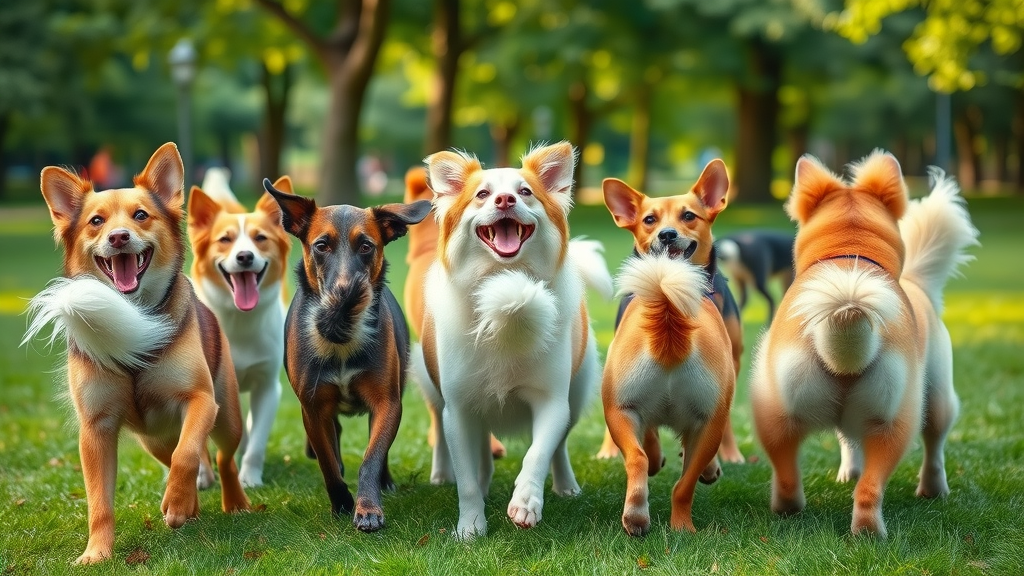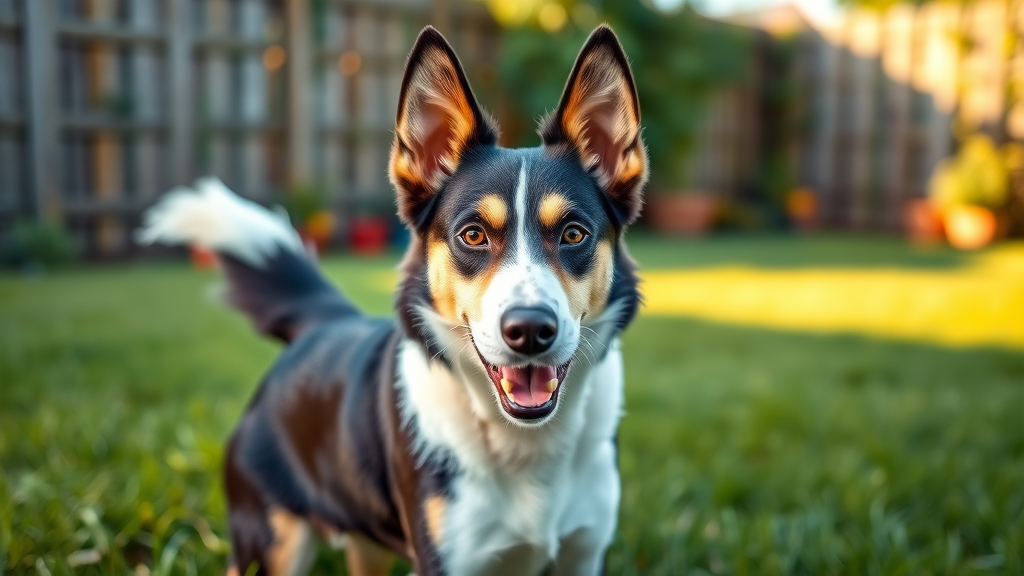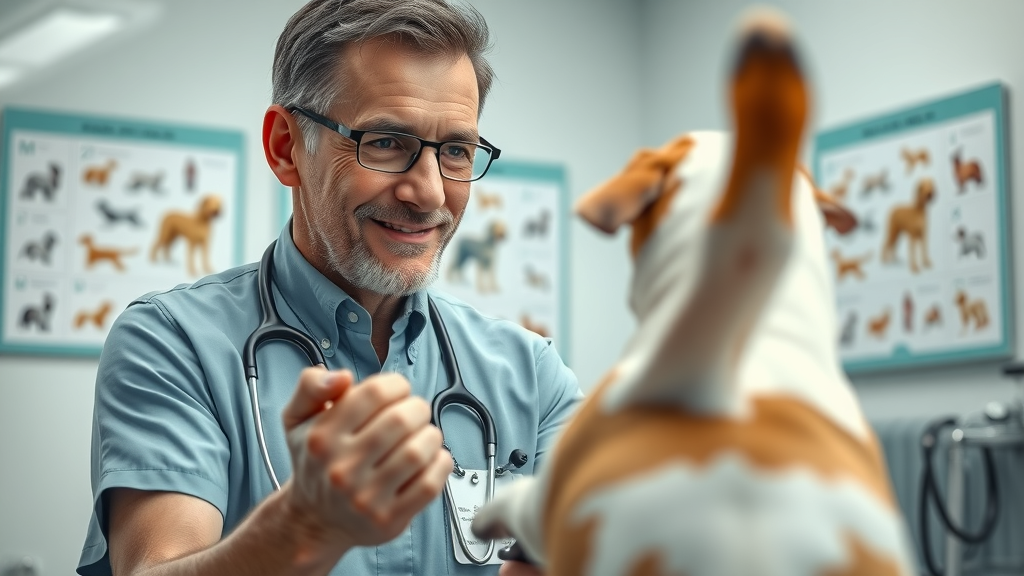Have you ever watched your dog’s tail wag and wondered, “Is that pure joy, or does it mean something more?” For centuries, tail wagging has puzzled pet owners and even animal experts. Are wagging tails a sign of happiness, nervous energy, or a secret language? This in-depth guide gets to the bottom of the mystery, blending science and real-world examples so you can finally answer: why do dogs wag their tails? Get ready to see your furry friend’s wags in a whole new light!

- Have you ever wondered what’s really going on when you see your dog’s tail wag? Is it pure happiness, or is there more beneath the surface? Dive deep into the fascinating science and social cues behind why dogs wag their tails, and you might just see your pet’s behavior in a whole new light.
Why Do Dogs Wag Their Tails? Unraveling the Mystery of Tail Wagging
Why do dogs wag their tails? It’s a question every dog parent has asked. While most people believe a wagging tail is the sign of a happy dog , the answer goes much deeper. Dogs wag their tails to communicate a range of feelings to other animals and humans. Think of it as their unique form of “talking”–one that can mean joy, excitement, concern, or even hesitation.
The movement of the tail , its speed, and the way the tail is held all matter. For example, a slow, low wag might show uncertainty, while a fast, broad sweep across the body typically means happiness. Understanding tail wagging helps you “read” your dog’s mood and intentions—making your bond even stronger. In this article, you’ll learn not just what different tail wags mean, but also why dogs developed this fascinating communication tool in the first place.
Key Insights: How Tail Wagging Reveals the Secret Language of Dogs
- A quick look at the body language behind tail wagging
- Surprising emotional cues wagged through tails
- What scientists have learned about how dogs communicate
Understanding Why Dogs Wag Their Tails: The Science Behind Tail Wagging
What Research Reveals About Dogs Wagging Their Tails

- Tail wagging isn’t just a sign of happiness—it’s a sophisticated means of canine communication.
- Dogs wag their tails to express a spectrum of emotions as well as to signal intentions to other animals and humans.
Scientists have studied dogs wagging their tails for decades and have found that this behavior is both complex and intentional. A significant study found that dogs use their tails not just to express happiness but to convey a wide range of emotions. For example, nervousness, fear, or uncertainty can also result in tail movement.
Rather than being only a “happy dog” signal, wagging tails offer clues to a dog’s state of mind. Detailed research shows that tail wags can demonstrate excitement, serve as submission signals, or even indicate stress. By paying attention to these subtle cues, you can better understand how your dog feels and reacts in different situations.
How Dogs Communicate with Tail Wags
- The direction and speed of a tail wag can indicate friendliness, uncertainty, or alertness.
- Left-wag versus right-side wagging: significant differences in communication and meaning.
Dogs communicate with each other and with people using many cues, but the tail wag stands out as one of the most visible. Tail wagging is not a one-size-fits-all motion. For instance, a tail that wags more to the right usually shows positive emotions, whereas a left-side wag relates to negative emotions or uncertainty. Speed plays a role, too: a slow wag might indicate hesitation, while a rapid, side-to-side movement is typically a sign of excitement.
Learning to interpret these differences will help you understand what your dog’s tail is “saying.” This awareness is essential in reading canine body language accurately—so you know whether your dog wags his tail because he’s thrilled to see you, or if he’s feeling uneasy about a new situation. Watching for the tip of the tail and how it moves can further clarify a dog’s intentions.
Tail Wagging in Context: Decoding Wagging Behaviour Across Situations
Social Scenarios: How Dogs Wag Their Tails Among Friends and Strangers
- Wagging behaviour during greetings, playtime, and unfamiliar encounters
- How wagging tail signals intent to other dogs
In social settings, tail wagging becomes even more important. When two dogs wag their tails during playtime, the message is clear: “Let’s have fun!” During greetings, a wag might show friendliness and cooperation. However, in unfamiliar environments or when meeting strangers, the wagging can take on a more cautious or even submissive meaning.
The next time your dog meets a new canine friend at the park, watch his tail movement closely. If his tail is wagging in wide, sweeping arcs, he’s likely feeling confident and sociable. But if the wag seems nervous—maybe with the tail held a bit lower or wagging slowly—your dog might be uncertain about the encounter. Paying attention to these subtle cues is key to understanding your pet’s social world.
Mood and Emotion: What Different Tail Wags Mean

- Happiness, excitement, nervousness, or fear—each tail wag has its own message
- A slow tail wag can indicate hesitation, while an exuberant wag may signal joy or high energy
Understanding your dog wag can help you interpret whether he’s feeling safe, excited, or a little anxious. For example, a happy dog often wags his tail vigorously, with his whole body sometimes joining the action! This high-energy wagging usually signals extreme joy, perhaps when you return home or offer a favorite toy.
Conversely, a tail that wags slowly—especially if the tail is held lower—may reflect uncertainty. Dogs don’t just wag their tails when they’re happy; sometimes a wagging tail is a way of displaying nervousness or trying to show submission during a tense moment. Always consider body language as a whole before concluding how your dog is feeling.
Do Dogs Control Their Tail Wagging? Exploring Voluntary and Involuntary Wagging
- Tail wagging is both a conscious and subconscious part of canine social signals
- How a dog’s brain works when dogs wag their tail, and what it means for behavior
Contrary to popular belief, dogs wag their tails with a mix of voluntary and involuntary muscle actions. While some wags are conscious decisions made to communicate specific intentions, other times the emotion bubbling inside simply takes over—resulting in an automatic wagging tail. Dogs use their tails to signal everything from excitement to caution, and their brains can activate tail movement long before we even notice it.
Researchers have discovered that the part of a dog’s brain responsible for emotions is closely linked to the control of tail movement. This means your furry friend may not always be aware when his tail wags during moments of strong joy, surprise, or stress. Recognizing this blend of voluntary and involuntary action is crucial for truly understanding what a wagging tail means from one situation to the next.
The Body Language of Tail Wagging: Not Just the Tail
Understanding the Full Context of Wagging Behaviour

- Tail wags take on different meanings depending on posture, ear position, and facial expressions
- Why watching the entire body is essential when interpreting dogs wagging their tails
It’s tempting to focus only on the tail wagging , but every dog wag is part of a bigger picture. Look at your dog’s ears—are they perked up or pinned back? Is his body loose and wiggly, or stiff and tense? Facial expression matters, too; a relaxed mouth and bright eyes usually pair with a happy wag, while a tight-lipped or squinting dog may be on edge.
The next time your wagging tail dog greets you, pay close attention to his overall posture. True positive emotions reveal themselves in a “whole body wag”—not just movement of the tail. Meanwhile, a tail held high and wagging stiffly could signal alertness or even assertiveness. If you pay attention to more than just the tail, you’ll gain a fuller understanding of your dog’s communication.
Tail Wagging Myths Busted: Does Wagging Always Mean Happiness?
- Common misconceptions about dogs wagging their tail spirits
- When tail wagging may point to aggression or anxiety
A common myth is that tail wagging always equals a happy dog . However, not every wag means your dog is thrilled. Sometimes, a dog wag is actually a sign of anxiety or even brewing aggression—especially when the tail is held high and moved in short, rigid motions or when overall body language appears tense.
"Not every wagging tail is a sign of happiness. Sometimes, it’s the dog’s way of saying, ‘I’m not sure about this.’" – Dr. Jane Goodwell, Animal Behaviorist
The key is context. If you notice a wagging tail paired with nervous shifting or a lowered body, your dog is likely unsure or even fearful. By learning to decode different types of wags, you can better protect both your dog and others during uncertain moments.
The Evolution of Tail Wagging: How Dogs Developed Their Signature Signal

- Why tail wagging became a vital part of canine communication during domestication
- Comparison of tail wags in wild canids versus domestic dogs
Tail wagging as a communication technique is a product of evolution, particularly accelerated during the domestication of dogs from wolves. While wolves use very limited tail wagging, mostly for submission within tight packs, domestic dogs have developed a far broader set of tail wags. The tail wagging in today’s domesticated breeds signals everything from an invitation to play to a reassurance of safety.
Scientists believe that as humans and dogs began to live and work closely, dog wags that were more expressive of friendliness and emotion were reinforced. Over generations, this has resulted in the variety of tail wagging behaviors we see today. While wild canids may use tail position for hierarchy, our pets use it for emotion-based social signaling.
| Behavior | Wolves | Domestic Dogs |
|---|---|---|
| Greeting tail wagging | Rare | Frequent |
| Playful tail wags | Limited | Abundant |
| Social signaling | Hierarchical | Emotion-based |
Are All Tail Wags Created Equal? Interpreting Differences Among Breeds
- Breed-specific tail wagging characteristics
- Short-tailed and curled-tail breeds: How they wag differently and what it means
Not all tail wags are the same across breeds. Some dogs have long, sweeping tails—think Golden Retrievers—while others have curled tails (like Akitas) or very short tails (like Bulldogs). The type, flexibility, and length of a dog’s tail can change not only how he wags but what the tail means in context.
Short-tailed breeds may rely more on whole-body movement or rapid “nub” wags, so it’s especially important to pay attention to other cues like body posture and facial expression. Curled or upright tails might not display traditional wags but can still flex and sweep to signal happiness or alertness. Get to know your breed’s “normal” so you can spot behavioral changes quickly.
Beyond Communication: When Tail Wagging Highlights Your Dog’s Wellbeing
Wagging Tail Frequency and Health Signals
- What consistent or excessive tail wagging can reveal about health and emotional well-being
- When to watch for concerning patterns
Frequent, enthusiastic tail wagging is usually a sign of a happy, healthy pup. But if you notice a sudden change—like your dog holding his tail still or repeatedly tucking it between his legs—this could point to pain or discomfort. Some medical conditions, including “limber tail syndrome” or injuries from excessive wagging, can result in a droopy or painful tail.
Always pay attention to changes in tail movement patterns. If your dog wags his tail too much, damage to muscles or nerves can occur. A lack of tail wagging, or a limp tail, warrants a trip to your vet for professional evaluation.
The Importance of Responsible Observation

- How being tuned into your dog’s tail wags and body language builds a stronger bond
- Pro tips for interpreting and responding to wagging behaviour
Being a responsible pet owner means learning to interpret every aspect of wagging behaviour. By observing not just how your dog wags , but when and why, you’ll understand what your dog is feeling and when he needs help, comfort, or space. This careful observation strengthens your connection and allows you to respond appropriately in any situation.
Always pair tail wagging analysis with checks on your dog’s energy level, appetite, and social behaviors. A little extra attention goes a long way in ensuring your four-legged friend’s happiness and well-being.
- Watch real-world tail wags in various emotional contexts
For a better understanding, watch videos showing dogs in different situations—play, nervousness, greeting, and more. Visual guides help you connect theory with real-life cues, so you can spot the subtleties in your own dog’s tail wagging .
- A breakdown of what tail wags mean by animal behaviorists
Expert videos feature animal behaviorists explaining how tail wagging works and what those wags truly mean. These resources provide practical demonstrations and scientific insights that take your understanding to a higher level.
- See adorable puppy tail wags and interpret their meanings
Puppies start learning to wag their tails within weeks of birth. Watching them develop these behaviors provides remarkable insight into how dogs wag to connect with their family and the world around them.
Quick Reference: Tail Wags and Their Meanings
| Type of Tail Wag | Likely Meaning |
|---|---|
| Broad, fast wagging | Joy, excitement |
| Low, slow wagging | Insecurity, caution |
| Rigid, upright wag | Alert, possible aggression |
| Wide, sweeping wag | Friendliness |
| Tucked tail with wag | Submissiveness, nervousness |
Popular Questions About Why Dogs Wag Their Tails
Are dogs really happy when they wag their tails?
- While a wagging tail often signals happiness, it can indicate a range of emotions. Context—including body language and environment—determines the most accurate interpretation.
A dog wag is often a signal of excitement, but it's essential to consider the tail's position, speed, and the rest of the dog's body language before concluding if your dog is truly happy. Sometimes, a wagging tail can even occur when a dog is feeling nervous or unsure.
Why does a dog wag its tail at you?
- A dog may wag its tail at you to greet you, show affection, or invite play. But the speed, direction, and position of the tail reveal how the dog is truly feeling in that moment.

Typically, dogs wag their tail when they’re excited to see a loved one or are in a playful mood. However, the exact message depends on how the tail moves and what the rest of the dog’s posture shows. A low, slow, or tucked wag might express caution rather than happiness.
Do dogs control their tail wagging?
- Tail wagging is a mix of voluntary and involuntary muscles. Dogs can control their tail movements to some degree, using them to communicate intentions, but strong emotions can trigger automatic wags.
Dogs can purposefully wag their tails to send specific signals, especially when interacting with people or other pets. Nonetheless, powerful emotional states, like excitement or anxiety, can trigger involuntary tail movement as well. This blend of control is why wagging behaviour can seem both random and intentional.
Does a wagging tail mean a dog is friendly?
- Not always. Though friendly dogs wag their tails, some wags, especially high or stiff wags, might signal assertiveness or agitation. Always observe the whole body and situation before approaching.
While a friendly wagging tail typically sweeps at mid-level, a high, firm wag might signal alertness or even aggression. Approach unfamiliar dogs carefully and assess overall body language , not just the tail, for a safe interaction.
Frequently Asked Questions About Dogs Wagging Their Tails

- Can tail wagging vary depending on breed?
- Is it normal for dogs to not wag their tails at all?
- What should I do if my dog suddenly stops wagging its tail?
- Do puppies learn wagging behaviour from their mothers or littermates?
Yes, tail wagging can be very different among breeds due to tail shape, length, and breed-specific behaviors. It’s normal for certain dogs to wag their tails less, especially if they’re more reserved or if their tails are short or curled. If your dog suddenly stops tail wagging or seems uncomfortable, consult your vet to rule out pain or injury. Puppies begin to learn wagging behaviour through social interaction with mothers and siblings, quickly picking up this “language” over the first few weeks of life.
Key Facts to Remember About Why Dogs Wag Their Tails
- Tail wags are an essential part of dog communication, offering insight into emotion and intent
- Observing the entire dog’s body language provides a full picture for interpreting wagging behaviour
Unlock a World of Insights for Pet Lovers
- Want more tips, stories, and pet care guides delivered straight to your inbox? Join our monthly PawPress newsletter and stay in the loop with the latest for your furry friends. 🐾 Subscribe now — your pets will thank you!
Ready to decode your dog’s tail language? Pay attention to the whole body, respond with care, and build a deeper bond every time your pup wags his tail!
Understanding the nuances of tail wagging can deepen your connection with your canine companion. For a comprehensive exploration of this behavior, consider the following resources:
-
Why Do Dogs Wag Their Tails? by Britannica delves into the evolutionary and communicative aspects of tail wagging, providing insights into how dogs use their tails to express a range of emotions.
-
Why Do Dogs Wag Their Tails? by the American Kennel Club offers expert advice on interpreting tail movements, emphasizing the importance of considering the entire body language to accurately understand a dog’s feelings.
These articles will equip you with a deeper understanding of your dog’s tail language, enhancing your ability to interpret their emotions and strengthen your bond.
 Add Row
Add Row  Add
Add 




Write A Comment